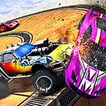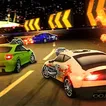
































































































































Racing Games: The Ultimate Guide to High-Speed Gaming Fun
Embark on a thrilling journey through the adrenaline-fueled world of racing games, a genre that combines the love of speed with the excitement of competition and the satisfaction of skillful maneuvering. This ultimate guide is your ticket to understanding the high-octane fun that racing games provide, from the roar of the engines to the screech of tires against the tarmac.
Racing games have long been a staple in the gaming community, offering a diverse range of experiences that cater to both the casual player looking for a quick adrenaline rush and the dedicated enthusiast seeking a deep and realistic simulation. The genre’s appeal lies in its ability to simulate the intense emotions of racing, the strategic thinking required to outpace opponents, and the precision needed to master the tracks.
Whether you’re navigating tight corners on a slick race track or battling through rugged terrain in an off-road challenge, racing games demand concentration, quick reflexes, and a willingness to push the limits. They provide a playground where players can experience the thrill of high-speed pursuits without the real-world risks, all within the comfort of their own home.
As you dive into this guide, you’ll discover the various facets that contribute to the enduring success of racing games. From the evolution of the genre that has seen graphics and gameplay mechanics become ever more sophisticated, to the social dynamics introduced by multiplayer modes that bring players together from around the globe, racing games continue to captivate and entertain.
So, buckle up and prepare to explore the dynamic and exhilarating world of racing games, where every second counts and every race is a new opportunity for glory.
Racing Game Evolution: From Arcade to Simulation
The genesis of racing games can be traced back to the simple yet addictive arcade machines that consumed countless quarters. These early games prioritized speed and instant gratification, offering players the chance to experience the thrill of racing without the complexities of real-world driving. With rudimentary controls and basic graphics, they laid the foundation for what would become a diverse and sophisticated genre.
As technology advanced, so did the racing games. The leap from two-dimensional sprites to three-dimensional environments marked a significant milestone, allowing for a more realistic portrayal of speed and movement. This evolution continued with the introduction of physics engines that accurately simulated vehicle dynamics, making the driving experience more lifelike than ever before.
Today’s racing simulations are a far cry from their arcade ancestors. They demand not only quick reactions but also a strategic approach to racing. Players must understand the nuances of vehicle handling, which varies from one car to another, and adapt their driving technique to the intricacies of each track. Weather conditions, tire wear, and fuel management add layers of strategy, requiring players to think like real racers.
The immersive nature of modern racing games is further enhanced by sophisticated AI that challenges even the most skilled players. The virtual opponents behave unpredictably, making each race a unique encounter. The realism extends beyond the track, with detailed car customization and maintenance that reflect the complexities of actual racing.
From pixelated cars zipping across a screen to hyper-realistic simulations that mimic every aspect of racing, the genre has undergone a remarkable transformation. This evolution has not only expanded the audience for racing games but also deepened the level of engagement, ensuring that the need for virtual speed continues to burn brightly in the hearts of gamers worldwide.
Car Racing Games: Engines, Excitement, and Endurance
Car racing games sit at the epicenter of the racing genre, offering a blend of raw power and refined technique that captures the essence of motorsports. These games are where virtual engines roar to life, and players are transported into the driver’s seat, facing the same challenges and decisions that real-world racers confront on the track.
The allure of car racing games lies in their balance of excitement and endurance. Players must harness the horsepower beneath the hood while managing the delicate dance of acceleration, braking, and steering. The thrill of overtaking opponents at breakneck speeds is matched by the need for strategic pit stops and tire management, making each race not just a test of reflexes but of resilience and foresight.
Track design plays a crucial role in car racing games, with each circuit offering a unique array of straights, chicanes, and hairpin turns that test a player’s ability to adapt and learn. Mastery of a track requires understanding its every nuance, from the ideal racing line to the spots where overtaking is possible. The tracks themselves become formidable opponents, challenging players to improve with every lap.
The depth of these games is further enriched by the intricate vehicle handling systems that simulate the distinct characteristics of various car models. Players must become attuned to the weight distribution, grip levels, and acceleration patterns of their chosen vehicles, often adjusting their driving style to match the car’s capabilities and the conditions of the race.
In essence, car racing games are a symphony of speed, strategy, and stamina, where the persistent pursuit of perfection can lead to virtual glory. They encapsulate the essence of racing—a test of both man and machine, where only the most skilled and strategic drivers will find themselves in the winner’s circle.
Racing Games Multiplayer: The Social and Competitive Landscape
The multiplayer aspect of racing games has revolutionized the way we play, turning what was once a solitary pursuit into a vibrant social experience. Online multiplayer modes connect speed enthusiasts from every corner of the globe, allowing them to compete in real-time races that are as fiercely competitive as any physical event. The sense of community is palpable, with players sharing tips, celebrating victories, and commiserating over losses.
This social dimension has given rise to a competitive landscape where reputation and rankings are at stake. Leaderboards and tournaments provide a platform for racers to prove their prowess and earn bragging rights. The thrill of racing against human opponents adds an unpredictable element to gameplay, as players must adapt to the varied driving styles and strategies of their competitors.
Community-driven events, such as time trials and custom championships, foster a sense of belonging and offer a structured way for players to engage with one another. These events often feature unique rules or themes, adding a fresh twist to the familiar rush of racing. They also serve as a meeting ground for players to form teams and forge alliances, adding a layer of camaraderie to the competitive spirit.
The multiplayer experience in racing games is not just about competition; it’s about connection. It’s a space where friendships are formed over shared passions, and rivalries are born from the desire to improve. Whether it’s a casual race with friends or a high-stakes tournament, the social and competitive landscape of racing games multiplies the excitement, making every victory that much sweeter and every defeat a lesson for the next challenge.
Conclusion: The Lasting Impact of Racing Games
Racing games have surged through decades of innovation to secure a pole position in the hearts of gamers. Their lasting impact is a testament to the genre’s ability to evolve with technology while maintaining the core thrill of the chase. The fusion of speed, strategy, and skill continues to captivate, offering a virtual adrenaline rush that mirrors the intensity of real-world racing.
The genre’s adaptability has seen it embrace new platforms and technologies, ensuring that it remains relevant and exciting. From the simplicity of early arcade games to the complex simulations of today, racing games have consistently pushed the boundaries of what is possible in a digital experience. They have grown to offer not just a form of entertainment, but a way to connect with others, to compete, and to be part of a community that shares a passion for speed.
As we look to the future, the potential for further innovation is boundless. With advancements in virtual and augmented reality, the line between game and reality blurs, promising even more immersive experiences. The social aspects will undoubtedly expand, bringing more players together for global competitions that celebrate the spirit of racing.
In conclusion, the enduring popularity of racing games is driven by their ability to provide an escape into a world of high-speed thrills, where every player can find their pace, challenge their limits, and feel the rush of victory. As the engines of innovation continue to rev, racing games will undoubtedly accelerate into new realms of gaming fun, ensuring their place in the digital pantheon for years to come.